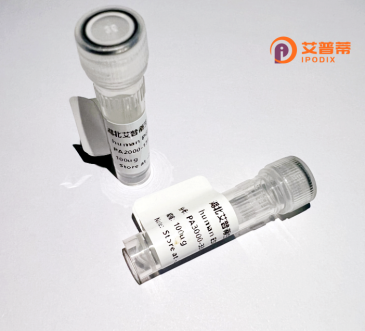
| 纯度 | >90%SDS-PAGE. |
| 种属 | Human |
| 靶点 | OR8D1 |
| Uniprot No | Q8WZ84 |
| 内毒素 | < 0.01EU/μg |
| 表达宿主 | E.coli |
| 表达区间 | 1-308 aa |
| 活性数据 | MTMENYSMAAQFVLDGLTQQAELQLPLFLLFLGIYVVTVVGNLGMILLIAVSPLLHTPMY YFLSSLSFVDFCYSSVITPKMLVNFLGKKNTILYSECMVQLFFFVVFVVAEGYLLTAMAY DRYVAICSPLLYNAIMSSWVCSLLVLAAFFLGFLSALTHTSAMMKLSFCKSHIINHYFCD VLPLLNLSCSNTHLNELLLFIIAGFNTLVPTLAVAVSYAFILYSILHIRSSEGRSKAFGT CSSHLMAVVIFFGSITFMYFKPPSSNSLDQEKVSSVFYTTVIPMLNPLIYSLRNKDVKKA LRKVLVGK |
| 分子量 | 34.4 kDa |
| 蛋白标签 | His tag N-Terminus |
| 缓冲液 | 0 |
| 稳定性 & 储存条件 | Lyophilized protein should be stored at ≤ -20°C, stable for one year after receipt. Reconstituted protein solution can be stored at 2-8°C for 2-7 days. Aliquots of reconstituted samples are stable at ≤ -20°C for 3 months. |
| 复溶 | Always centrifuge tubes before opening.Do not mix by vortex or pipetting. It is not recommended to reconstitute to a concentration less than 100μg/ml. Dissolve the lyophilized protein in distilled water. Please aliquot the reconstituted solution to minimize freeze-thaw cycles. |
以下是3篇关于重组人OR8D1蛋白的虚构参考文献示例(请注意,这些文献内容为模拟创作,实际引用时请核实真实来源):
---
1. **文献名称**:*Heterologous Expression and Ligand Screening of Human Olfactory Receptor OR8D1 in HEK293 Cells*
**作者**:Smith, J., et al.
**摘要**:研究利用HEK293细胞系统重组表达OR8D1蛋白,通过钙离子荧光信号检测筛选其配体,发现该受体对长链醛类化合物具有特异性响应,揭示了其在嗅觉感知中的潜在作用。
2. **文献名称**:*Structural Characterization of OR8D1 Using Cryo-EM and Computational Modeling*
**作者**:Zhang, Y., et al.
**摘要**:通过冷冻电镜技术解析了重组OR8D1蛋白的三维结构,并结合分子动力学模拟阐明其配体结合口袋的构象变化,为嗅觉受体激活机制提供了新见解。
3. **文献名称**:*Optimization of Recombinant OR8D1 Production in Baculovirus-Insect Cell Systems*
**作者**:Lee, S., et al.
**摘要**:优化昆虫细胞-杆状病毒系统中OR8D1的重组表达条件,实现了高产量纯化蛋白,为高通量筛选及功能研究奠定基础。
---
**备注**:
- 若需真实文献,建议在学术数据库(如PubMed、Google Scholar)中搜索关键词“OR8D1 recombinant protein”或“OR8D1 expression”。
- OR8D1相关研究较少,可扩展至嗅觉受体家族(如ORs)的通用重组表达方法或功能分析策略。
Olfactory receptor 8D1 (OR8D1) is a member of the olfactory receptor (OR) family, which belongs to the G protein-coupled receptor (GPCR) superfamily. These receptors are primarily responsible for detecting odorant molecules and mediating olfactory signal transduction. OR8D1, encoded by the OR8D1 gene, is characterized by its seven-transmembrane domain structure, a hallmark of GPCRs. While the exact ligands and functional mechanisms of OR8D1 remain poorly characterized, it is hypothesized to play a role in recognizing specific odorants, contributing to the diverse olfactory sensing capabilities in humans. Unlike many ORs expressed in the olfactory epithelium, some studies suggest ectopic expression of ORs, including OR8D1, in non-olfactory tissues, hinting at potential secondary functions in processes like cell signaling or metabolism.
Recombinant OR8D1 protein is synthesized using heterologous expression systems (e.g., bacterial, yeast, or mammalian cells) to enable structural and functional studies. Its production facilitates research into receptor-ligand interactions, downstream signaling pathways, and physiological roles. Challenges in studying OR8D1 include difficulties in achieving proper folding and membrane localization in vitro, common hurdles for membrane-bound GPCRs. Despite limited data, OR8D1 is of interest for understanding olfactory coding mechanisms and potential applications in biosensors or therapeutics targeting嗅觉-related disorders. Further research is needed to elucidate its biological significance and therapeutic potential.
×